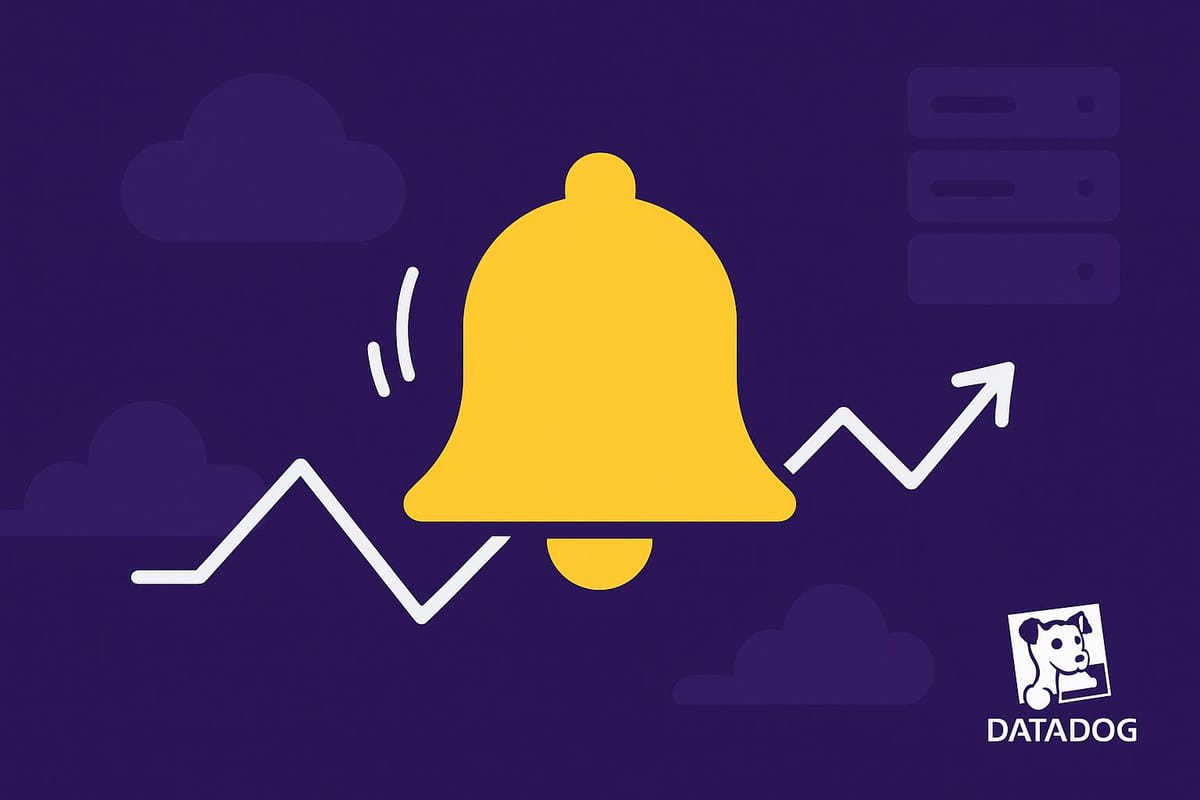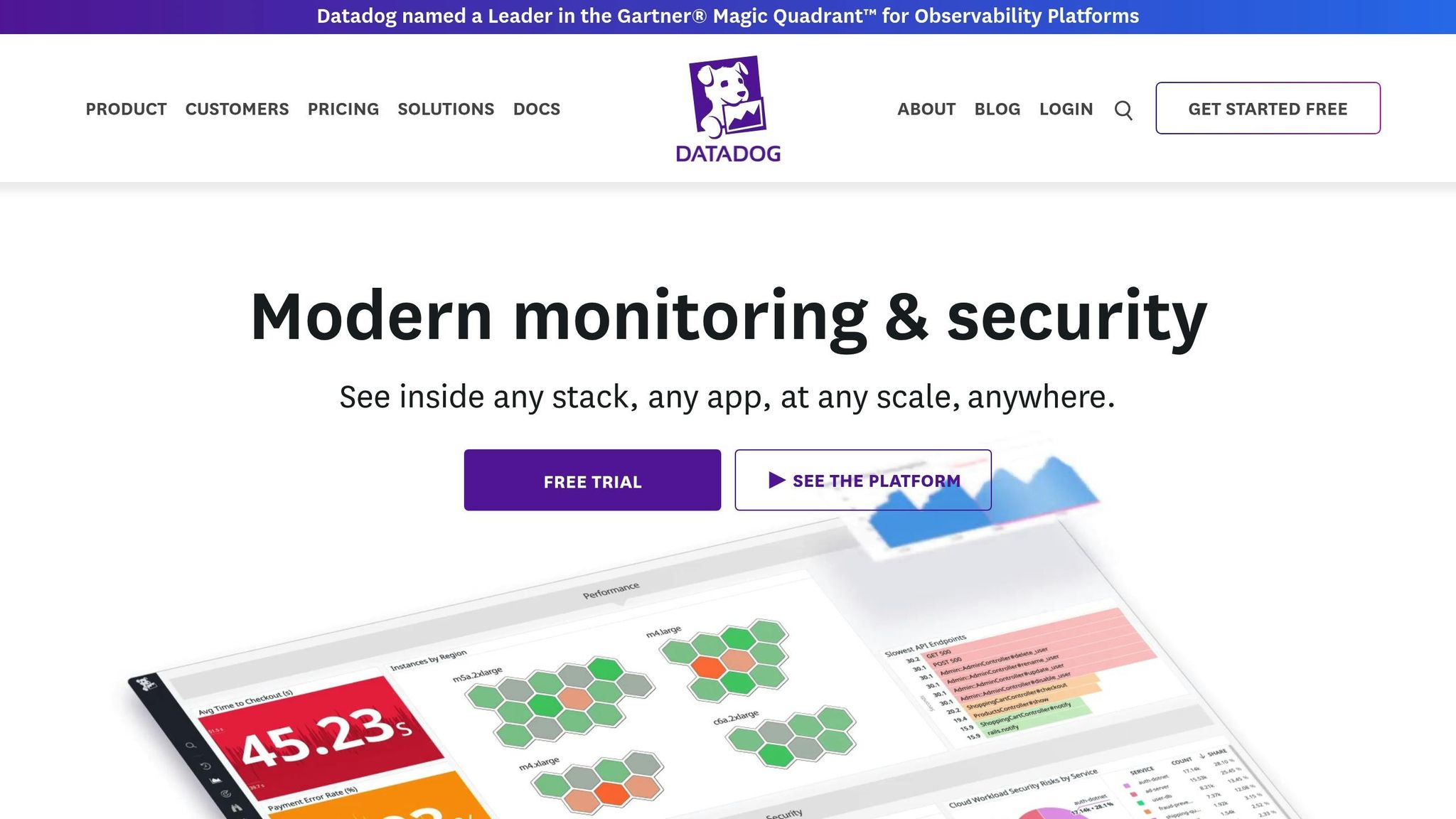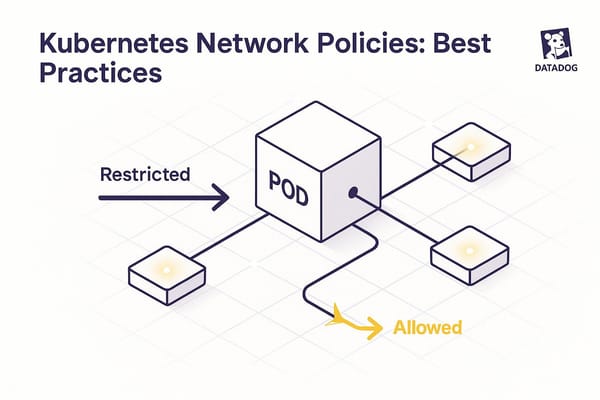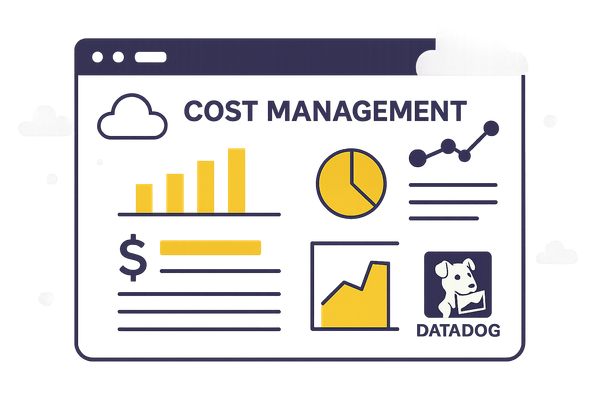Recovery Alert Configuration: Best Practices
Learn best practices for configuring recovery alerts in Datadog to minimize downtime, reduce alert fatigue, and ensure efficient resource management.

Recovery alerts in Datadog notify you when systems return to normal after an issue. They're different from standard alerts, which flag problems. These alerts help avoid unnecessary noise, confirm resolution, and improve resource management, especially for small and medium-sized businesses (SMBs). Key points include:
- Recovery Thresholds: Set conditions (like CPU usage stabilizing below 70%) to ensure issues are fully resolved before marking them as fixed.
- User-Focused Metrics: Prioritize metrics like response times or error rates that directly impact customers.
- Dynamic Notifications: Use template variables (e.g.,
{{value}}) for detailed, context-aware alerts. - Tagging & Routing: Route alerts to the right teams using service-based tags (e.g.,
service:payment-processing). - Automation: Suppress alerts for decommissioned resources and use workflows to streamline recovery processes.
Recovery alerts are essential for minimizing downtime, reducing alert fatigue, and ensuring teams focus on what matters. Below, learn how to configure them effectively and avoid common mistakes.
I07.2 How to Build Smarter Alerts in Datadog (is_match, Anomalies, Downtime!)

Core Principles for Configuring Recovery Alerts
When it comes to setting up recovery alerts, the goal is to strike a balance between precision and practicality. These principles aim to help small and medium-sized businesses (SMBs) focus on what truly matters, minimizing unnecessary noise while keeping alert fatigue in check. By integrating these practices into your overall monitoring strategy, your alerts will remain actionable, relevant, and easy to manage.
Focus on User-Facing Metrics
When configuring recovery alerts, user-facing metrics should take center stage. These metrics reflect the actual experience of your customers, making them far more actionable than internal system metrics that might not immediately affect users.
For SMBs, this means focusing on metrics that directly impact user experience, like response times, error rates, availability, and transaction success rates. For example, instead of setting alerts for every spike in CPU usage or memory fluctuations, monitor metrics such as the 95th percentile response time. If your payment processing service recovers its normal transaction speeds after an outage, a recovery alert ensures you know that customers can successfully complete purchases again - something that directly ties to revenue. In contrast, a server metric might recover while users still face issues.
Metrics tied to Service Level Indicators (SLIs) are especially effective for recovery alerts. SLIs measure user experience directly, such as API response times under 200ms, error rates below 1%, or uptime exceeding 99.9%. When these metrics return to acceptable levels, recovery alerts provide clear confirmation that your service quality is back on track.
The key is to distinguish between symptoms and causes. Symptoms directly affect users, while causes are internal system issues that might not immediately impact the user experience. Recovery alerts are most effective when they focus on tracking symptom resolution rather than the underlying technical fixes.
Use Conditional Logic and Template Variables
Dynamic, context-aware recovery alerts are far more effective than generic notifications. Tools like Datadog allow you to use template variables to include detailed, situation-specific information in your alerts. Instead of sending a vague "service is back to normal" message, you can craft notifications that specify what recovered and provide the current system status.
Template variables like {{value}}, {{threshold}}, and {{host.name}} can make your recovery alerts much more informative. For example, you can include the exact response time or error rate that triggered the recovery alert. Adding conditional logic allows you to fine-tune your alerts further, ensuring they only trigger after multiple conditions are met.
For instance, you can set multi-condition recovery thresholds to avoid premature notifications. Instead of resolving an alert the moment a metric crosses back over the threshold, you could require additional conditions, such as response time staying below 200ms and error rates remaining under 0.5% for at least five minutes. This approach is especially useful for SMBs, as it prevents false recoveries that can erode confidence in your monitoring system and contribute to alert fatigue.
With dynamic templates and conditional logic in place, you can ensure your recovery alerts are both precise and meaningful.
Tagging for Better Notification Routing
Strategic tagging is another effective way to ensure recovery alerts reach the right people at the right time. By applying tags based on service, environment, or criticality, you can route notifications automatically to the teams that need them, aligning alerts with business priorities and operational context.
For example, service-based tags like service:checkout, service:user-auth, or service:payment-processing can help route recovery alerts to the appropriate teams. If your payment processing service recovers from an outage, the finance and operations teams can receive immediate confirmation, while the development team gets the technical details about the resolution.
Tags can also support time-based routing, which is particularly useful for SMBs with limited after-hours support. For instance, non-critical recoveries can be routed differently based on whether it’s during business hours or overnight, ensuring that on-call staff aren’t unnecessarily disturbed while still keeping everyone informed about system health.
When combined with Datadog’s notification rules, tagging creates a self-sufficient system where recovery alerts automatically reach the right individuals without requiring manual intervention or overly complex routing setups. This ensures that your team stays informed and focused without being overwhelmed.
Step-by-Step Guide to Setting Up Recovery Alerts
This guide walks you through the process of configuring recovery alerts in Datadog, ensuring your team gets the right notifications at the right time.
Configuring Monitors with Recovery Thresholds
Recovery thresholds are essential for avoiding flapping alerts, as they create a buffer between when an alert is triggered and when it’s marked as resolved.
When setting up a monitor in Datadog, you’ll find the recovery threshold option under the Set alert conditions section. The goal here is to set a recovery threshold that confirms the issue is fully resolved. For instance, if your alert triggers when response times exceed 500 ms, you might set the recovery threshold at a lower value, such as 450 ms, to ensure the system has stabilized before marking the alert as recovered.
Recovery thresholds can be applied to both alert and warning states, offering precise control over when your team is notified of a resolution. Keep in mind that an alert only transitions to a "recovered" state when the metric crosses the defined threshold. Choose these values wisely, considering your service's usual performance metrics.
Once thresholds are in place, the next step is to customize how recovery notifications are delivered to your team.
Customizing Recovery Notifications
Generic messages like "Alert resolved" don’t provide much clarity. Instead, use Datadog’s template variables to craft detailed, meaningful notifications that explain what recovered and why it matters.
For example, you can use variables like {{value}} to display the current metric value, {{threshold}} for the threshold that was crossed, and {{host.name}} or {{service}} to identify the affected component. A more informative notification might say: "API service response time recovered to {{value}} ms (threshold: {{threshold}} ms) on {{host.name}}."
You can also add conditional logic to make messages more dynamic, such as varying the content based on the duration or severity of the issue. Including business context can make these notifications even more impactful. For example, if your e-commerce checkout system recovers, highlight that customers can now complete purchases. Or, if an API service recovers, mention that third-party integrations are operational again. This additional context helps technical and non-technical stakeholders understand the importance of the recovery.
For more complex recovery scenarios, specify which conditions were resolved. Instead of a vague "all systems normal", your notification might say: "API service fully recovered, now meeting all defined performance criteria." This level of detail reassures your team and stakeholders about the system’s health.
After customizing your notifications, take advantage of scheduling and grouping features to optimize alert management.
Scheduling and Grouping Notifications
Streamlined scheduling and grouping can help reduce unnecessary interruptions, especially during maintenance or off-hours.
Scheduling Downtimes: Before planned updates or infrastructure changes, schedule downtimes in Datadog to suppress both alerts and recovery notifications. This prevents a flood of messages when systems come back online after maintenance. Use tags to filter by environment or service, ensuring only relevant notifications are suppressed.
Grouping Notifications: Consolidating related recovery alerts into a single message reduces noise while maintaining visibility. For example, instead of receiving separate alerts for each instance, group them by service, tag, or environment. This is especially helpful when multiple components recover at the same time.
For smaller teams with limited on-call resources, consider using time-based notification routing. Critical recoveries can trigger immediate alerts, while less urgent ones can wait until regular business hours. This approach ensures your team stays informed without unnecessary after-hours disruptions.
Event Correlation: When several components recover from the same root cause, Datadog can correlate these alerts into a single event. This provides a clearer picture of system health and reduces the mental load of processing multiple notifications.
Optimizing Recovery Alerts for SMBs
Small and medium-sized businesses (SMBs) often juggle limited IT resources, tight budgets, and competing priorities. This makes it crucial to configure recovery alerts in a way that delivers real value without overwhelming teams with unnecessary notifications.
Automate Alert Muting for Decommissioned Resources
Recovery alerts for systems that are no longer in use can quickly become a nuisance. SMBs frequently deploy temporary resources for tasks like testing or handling seasonal traffic surges, but it’s easy to forget to disable monitoring for these resources once they’re decommissioned. Tools like Datadog simplify this process by automatically muting alerts for terminated resources, such as Azure VMs, Amazon EC2 instances, or Google Compute Engine instances, when their autoscaling services shut them down.
You can take this a step further with Workflow Automation to suppress alerts for dependent services during planned downtimes. This ensures that your team isn’t distracted by irrelevant notifications while focusing on scheduled maintenance.
Another powerful strategy is to implement automated remediation. By setting up predefined actions for specific alerts, issues can often be resolved without requiring human intervention. This reduces manual workload and speeds up recovery times.
While automation is a game-changer, it’s equally important to regularly evaluate and fine-tune your alert configurations.
Review and Adjust Alert Settings Regularly
Monitoring setups are not "set it and forget it." As your systems evolve, so do the demands on your monitoring tools. Without regular updates, alerts can become less accurate and contribute to alert fatigue.
To keep your alerts effective, schedule periodic reviews of their settings. Look at factors like how often alerts are triggered and whether they provide actionable insights. Adjust thresholds, notification routing, and other parameters to ensure every alert serves a purpose. This proactive approach helps maintain a strong signal-to-noise ratio, so your team can focus on the issues that matter most.
Common Mistakes in Recovery Alert Configuration and How to Avoid Them
Small and medium-sized businesses (SMBs) often run into trouble when setting up recovery alerts, usually because they rush through the process or misunderstand how these alerts work. Tackling these issues early can save time and reduce unnecessary stress.
Misconfigured Thresholds
One of the most frequent errors is setting recovery thresholds that are either too strict or too relaxed. If thresholds are too sensitive, recovery alerts might trigger at the slightest sign of improvement - even if the core problem hasn’t been fully resolved. This creates a frustrating loop of false recoveries followed by new alerts. On the other hand, thresholds that are too lenient delay recovery notifications, leaving teams uncertain about whether the issue has been fixed.
The solution? Strike a balance that fits your environment. A good starting point is to use an evaluation window of 10–15 minutes and require 2–3 consecutive data points to confirm recovery. Here's a quick guide:
| Alert Component | Recommended Setting | Purpose |
|---|---|---|
| Evaluation Window | 10–15 minutes | Reduces false positives from temporary spikes |
| Recovery Threshold | 2–3 data points | Confirms resolution before updating the status |
Make sure to test these settings during non-critical times, and adjust them based on how your system behaves. Additionally, provide clear context in recovery alerts so teams fully understand what’s been resolved.
Insufficient Recovery Message Context
Even with well-tuned thresholds, recovery alerts are only effective if they include detailed information. Vague messages like "Issue resolved" leave teams guessing. Without details about what was fixed, how long the issue lasted, or whether follow-up is needed, teams may waste time digging through logs for answers.
A strong recovery message should include specifics like the recovered metric, when the issue started, and any relevant system details. Tools like Datadog’s Monitor Status page can be incredibly helpful, offering a centralized view with rich context for alerts. This makes it easier for teams to grasp both the problem and its resolution. You can also use the Event Details section to provide runbook-style guidance, which can streamline troubleshooting efforts.
Conclusion
Setting up effective recovery alerts is crucial for small and medium-sized businesses aiming to maintain dependable systems. The trick is to strike a balance between thorough monitoring and efficient use of resources.
Start by focusing on metrics that directly impact users, and then gradually expand your monitoring efforts. Recovery alerts aren’t just about identifying when issues are resolved - they’re about ensuring consistent performance and easing the chaos that system outages can bring.
The most successful SMBs treat recovery alert configuration as an ongoing process. Regularly revisit and fine-tune thresholds and notifications to streamline troubleshooting. Alerts that clearly explain what was resolved and when allow your team to shift their focus from putting out fires to making proactive improvements.
As your systems grow, the principles in this guide can help you scale your monitoring without adding unnecessary complexity. Whether you’re managing a single application or multiple services, the core approach stays the same: clear thresholds, actionable notifications, and alerts that genuinely support your team’s efficiency.
FAQs
How can I configure recovery alerts in Datadog to avoid false alarms and reduce alert fatigue?
To make recovery alerts in Datadog more effective and avoid overwhelming your team with unnecessary notifications, it's essential to fine-tune your alert settings. Start by adjusting thresholds and extending evaluation windows to cut down on false positives. This way, alerts will only trigger when they’re genuinely needed.
Another useful approach is setting up recovery thresholds - specific conditions that must be met before clearing an alert. This gives you more control over when recovery notifications are sent. You might also want to consolidate related alerts to reduce clutter and use anomaly detection to pinpoint unusual patterns, helping you focus on what truly matters. These strategies can be especially helpful for SMBs working with limited resources, ensuring your monitoring stays effective without becoming overwhelming.
Which user-facing metrics should I focus on when setting up recovery alerts in Datadog?
When setting up recovery alerts, it's important to focus on user-facing metrics that directly influence both user experience and system performance. Here are some key metrics to keep an eye on:
- Error rates: Look out for sudden increases in errors that might interfere with user activities.
- Page load times: Make sure your site or app loads quickly to avoid frustrating delays for users.
- Login failures: Monitor failed login attempts to quickly resolve any authentication problems.
- Latency: Track response times to ensure your system maintains smooth and efficient performance.
Concentrating on these metrics helps you tackle the issues that impact users the most, keeping their experience smooth and trouble-free.
How do dynamic notifications and tagging make recovery alerts more effective in Datadog?
Dynamic notifications and tagging in Datadog bring a sharper focus to recovery alerts, making them more precise and useful. With tags, you can group alerts by factors like environment, service, or severity. This way, notifications are sent directly to the right teams or individuals, cutting through confusion and ensuring immediate attention where it’s needed most.
Dynamic notifications go even further by combining tags with variables to build adaptable, context-aware alert rules. These rules adjust to real-time changes, filtering out unnecessary alerts and speeding up response times. For SMBs with limited resources, this method keeps recovery alerts targeted and manageable, allowing teams to stay on track and efficient.




